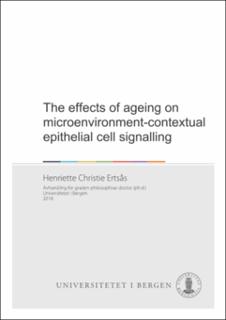| dc.contributor.author | Ertsås, Henriette Christie | en_US |
| dc.date.accessioned | 2018-07-05T12:11:04Z | |
| dc.date.available | 2018-07-05T12:11:04Z | |
| dc.date.issued | 2018-04-06 | |
| dc.identifier.isbn | 978-82-308-3804-4 | en_US |
| dc.identifier.uri | https://hdl.handle.net/1956/17872 | |
| dc.description.abstract | Age is the greatest risk factor for developing cancer. Two-thirds of cancer diagnoses occur in people over the age of 65. This increased vulnerability to tumourigenesis is attributed to intrinsic cellular changes, in particular the agerelated telomere shortening and the accumulation of mutations over time and. We propose that extrinsic factors comprising age-related alterations in the tissue microenvironment are also important in cancer development. We sought to elucidate how the microenvironmental affects cells, and how this is related to cancer development. This knowledge can be utilized to improve prevention, diagnosis and treatment of cancer in our ageing population. Cellular function is coordinated by microenvironmental factors such as growth factors, cytokines as well as extracellular matrix proteins. Soluble factormediated signal transduction is strongly influenced by microenvironmental context. To allow single cell level measurement of the microenvironmental contextual effect on cell signaling, we developed a novel flow cytometry method: microsphere cytometry. Single normal or neoplastic cells were adhered to uniform microspheres that display mimetic-microenvironments comprising surface combinations of extracellular matrix (ECM) in the presence of soluble agonists or antagonists. Temporal signaling responses were measured with fluorophore-conjugated antibodies that recognize responsedependent epitopes by multiparametric flow cytometry. Using this approach, we demonstrated that microenvironment-mimetic combinations of growth factors and extracellular matrix proteins generate distinct cellular signaling signatures from normal and patient biopsy-derived neoplastic cells. We asked whether the ageing process affects how human mammary epithelial cells (HMEC) respond to microenvironmental signals, and if this altered response results in increased susceptibility to oncogenic transformation. Using microsphere cytometry we analyzed age-dependent changes in human mammary myoepithelial and luminal epithelial cells exposed to different ECM and growth factors. We found that ECM–mediated MAP kinase and PI3K pathway activation levels in HMEC are attenuated with age, and that the diminished signaling magnitude in HMEC from ageing women correlated with reduced probability of activating oncogene-induced senescence. Our results suggest that attenuated cell signaling response may reduce the likelihood of activating oncogene induced senescence, for cells in ageing women. We hypothesize this is the result of age-related changes to the microenvironment that support age-emergent cellular phenotypes with increased cancer susceptibility. | en_US |
| dc.language.iso | eng | eng |
| dc.publisher | The University of Bergen | eng |
| dc.relation.haspart | Paper I: Ertsås, H.C., Nolan, G.P., LaBarge, M.A., Lorens, J.B. (2017). Microsphere cytometry to interrogate microenvironment-dependent cell signaling. Integr. Biol, 9(2), pp.123–134. The article is not available in BORA due to publisher restrictions. The published version is available at: <a href="https://doi.org/10.1039/c6ib00207b" target="blank">https://doi.org/10.1039/c6ib00207b</a> | en_US |
| dc.relation.haspart | Paper II: Ertsås, H.C., LaBarge, M.A., Lorens, J.B. Microenvironment-contextual cell signaling is attenuated with age. The article is not available in BORA. | en_US |
| dc.rights | Attribution-NonCommercial CC BY-NC. This item's Creative Commons-license does not apply to the included articles in the thesis. | eng |
| dc.rights.uri | http://creativecommons.org/licenses/by-nc/4.0/ | eng |
| dc.title | The effects of ageing on microenvironment-contextual epithelial cell signalling | en_US |
| dc.type | Doctoral thesis | |
| dc.rights.holder | Copyright the author | |
| dc.identifier.cristin | 1577970 | |

